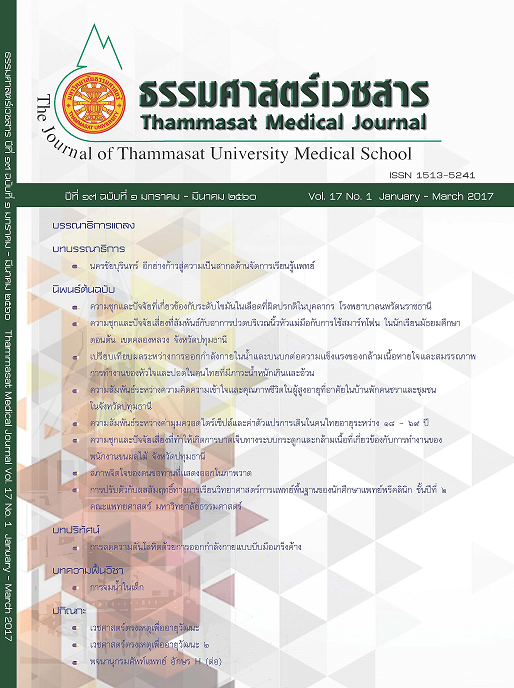Comparison between the effects of aquatic and land based exercise on respiratory muscle strength and cardio-pulmonary fitness in Thai overweight and obese participants
Keywords:
Aquatic exercise, Obesity, Overweight, Respiratory muscle strength, Cardio-pulmonary fitness, ออกกำลังกายในน้ำ, อ้วน, น้ำหนักเกิน, ความแข็งแรงกล้ามเนื้อหายใจ, สมรรถภาพการทำงานของหัวใจและปอดAbstract
Introduction: Symptoms of breathlessness during activities are common problems among overweight and obese individuals. Further, obesity and overweight can lead to pulmonary and cardiovascular impairments. Several studies had recommended aerobic exercise for these participants. However, this type of exercise (i.e., landed exercise) is difficult for a person with overweight because of excessive weight bearing and results in aggravates pain at lower extremities. Therefore aquatic exercise may be an alternative exercise for individuals who suffer from obesity or overweight. The purpose of this study was to compare the effects of aquatic exercise training and land based exercise training on respiratory muscle strength and cardio-pulmonary fitness in Thai overweight and obese.
Method: The participants were male and female with overweight and obese; body mass index = 25.0 - 34.9 kg/m.2 and waist to height ratio > 0.5. All participants were randomized into two groups: Aquatic exercise (N = 25) and Land based exercise (N = 25). Each group was asked to exercise 3 times a week for 4 weeks. Respiratory muscle strength (maximal inspiratory pressure; MIP and maximal expiratory pressure; MEP) and 6 minute walk test were measured before and after training.
Result: Aquatic exercise after training presented statistically significant increase in MIP and MEP (+13.53 ± 15.66 cmH2O and +16.00 ± 18.94 cmH2O, respectively) whereas land based exercise was not significantly different. Distance from the 6 minute walking test (6MWT) increased significantly after training in both groups (+17.02 ± 30.10 m. and +10.60 ± 25.36 m., respectively).
Discussion and Conclusion: Aquatic exercise increased respiratory muscle strength and cardio-pulmonary fitness in overweight and obesity.
บทนำ: ผู้ที่มีภาวะน้ำหนักเกินและอ้วน มีอาการหายใจลำบากขณะทำกิจกรรมต่างๆ และส่งผลต่อประสิทธิภาพการ ทำงานของระบบหายใจและหลอดเลือดลดลง มีการศึกษามากมายที่แนะนำการออกกำลังกายแบบ aerobic exercise ในกลุ่มที่มีน้ำหนักเกินมาตรฐานและอ้วน อย่างไรก็ตามลักษณะการออกกำลังกายดังกล่าว (การออกกำลังกายบนบก) ยังเป็นสิ่งที่ยากสำหรับกลุ่มดังกล่าวเนื่องจากการลงน้ำหนักที่มากเกินไปซึ่งส่งผลต่อการเพิ่มอาการปวดรยางค์ส่วนล่าง การออกกำลังกายในน้ำจึงอาจเป็นอีกทางเลือกหนึ่งในการออกกำลังกายสำหรับผู้ที่มีภาวะดังกล่าว ผู้วิจัยจึงสนใจที่จะศึกษาผลของการออกกำลังกายในน้ำและบนบกเพื่อเปรียบเทียบค่าความ
วิธีการศึกษา: อาสาสมัครเพศชายและหญิง มีค่าดัชนีมวลกายเท่ากับ ๒๕.๐ - ๓๔.๙ กิโลกรัมต่อเมตร๒ และอัตราส่วนรอบเอวหารส่วนสูง > ๐.๕ จำนวน ๕๐ คน แบ่งเป็น ๒ กลุ่ม โดยการสุ่ม คือ กลุ่มออกกำลังกายในน้ำ (Aquatic exercise; N = 25) และกลุ่มออกกำลังกายบนบก (Land based exercise; N = 25) อาสาสมัครจะไดรั้บการฝึก จำนวน ๓ วันต่อสัปดาห์ เป็นระยะเวลา ๔ สัปดาห์ อาสาสมัครทำการทดสอบความแข็งแรงของกล้ามเนื้อหายใจเข้า (MIP) และออก (MEP) และวัดระยะทางที่ได้ภายหลังการเดิน ๖ นาที (6MWT) ก่อนและหลังเข้าร่วมโปรแกรม
ผลการศึกษา: ภายหลังการฝึกกลุ่มออกกำลังกายในน้ำมีค่า MIP และ MEP เพิ่มขึ้นอย่างมีนัยสำคัญทางสถิติ (+๑๓.๕๓ ± ๑๕.๖๖ เซนติเมตรน้ำ และ +๑๖.๐๐ ± ๑๘.๙๔ เซนติเมตรน้ำ ตามลำดับ) ในขณะที่กลุ่มออกกำลังกายบนบกไม่มีการเปลี่ยนแปลงอย่างมีนัยสำคัญทางสถิติ และทั้งกลุ่มออกกำลังกายในน้ำและบนบกมีค่าระยะทางการเดิน (6MWT) เพิ่มขึ้นอย่างมีนัยสำคัญทางสถิติ (+๑๗.๐๒ ± ๓๐.๑๐ เมตร และ +๑๐.๖๐ ± ๒๕.๓๖ เมตร ตามลำดับ)
วิจารณ์ และสรุปผลการศึกษา: การฝึกออกกำลังกายในน้ำสามารถเพิ่มความแข็งแรงของกล้ามเนื้อหายใจและสมรรถภาพหัวใจและปอดในผู้ที่มีภาวะน้ำหนักเกินและอ้วนได้



